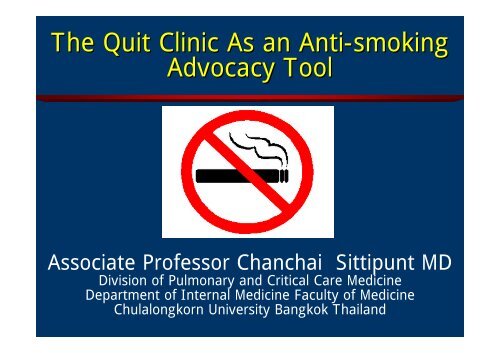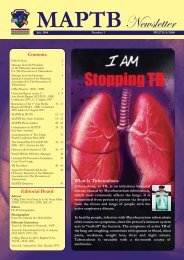The Quit Clinic As an Anti-smoking Advocacy Tool - MAPTB
The Quit Clinic As an Anti-smoking Advocacy Tool - MAPTB
The Quit Clinic As an Anti-smoking Advocacy Tool - MAPTB
You also want an ePaper? Increase the reach of your titles
YUMPU automatically turns print PDFs into web optimized ePapers that Google loves.
<strong>The</strong> <strong>Quit</strong> <strong>Clinic</strong> <strong>As</strong> <strong>an</strong> <strong>Anti</strong>-<strong>smoking</strong><strong>Advocacy</strong> <strong>Tool</strong><strong>As</strong>sociate Professor Ch<strong>an</strong>chai Sittipunt MDDivision of Pulmonary <strong>an</strong>d Critical Care MedicineDepartment of Internal Medicine Faculty of MedicineChulalongkorn University B<strong>an</strong>gkok Thail<strong>an</strong>d
Nicotine Addiction: Chronic DiseaseChronic intake of nicotinefrom cigarettesNicotine addiction is aCh<strong>an</strong>ges to theneural circuitscontrolling motivationchronic diseaseNicotine hunger Nicotine habit False beliefsA biologically driven“need” to smokewhen nicotine levelsin the brain are lowCues associated with<strong>smoking</strong> triggernicotine-drivenreward seekingExperience of reliefof nicotine withdrawalsymptoms leads toexpectations of moregeneral moodenh<strong>an</strong>cement
Long-Term <strong>Quit</strong> Rates Highest WithCombination Pharmacotherapy<strong>an</strong>d Behavioral SupportBehavior<strong>The</strong>rapyBrief AdviceNo <strong>The</strong>rapyMedication30%20%10%No Medicationor placebo15%10%5%Hughes JR. CA C<strong>an</strong>cer J Clin. 2000;50:143-151.
Cost-effectiveness of Smoking Cessationper life-year saved:Smoking Cessation $ 2,000 – 6,000R x of Hypertension $ 9,000 – 26,000R x of Hyperlipidemia $ 50,000 – 196,000Benowitz NL Prog Cardiovasc Dis 2003;46:91-111111
Treating <strong>smoking</strong> dependence versusmoderate hypertensionNumber needed to treatfor 1 incidentTreatment durationProtection gained fromtreatmentFrequency of sideeffectsCostReimbursementFrequency of practiceSmokingCessation14-283 monthsLoweredsusceptibility to 15-20diseaseLowLowNoneRarely<strong>Anti</strong>hypertensiveTreatment280ProlongedImproved heart <strong>an</strong>dblood vessel functionCommonHighYesOften
M<strong>an</strong>aging Smoking In 2007•Treat it as a chronic disease•Local guideline & “5 A’s” Model•Facilitating behavior ch<strong>an</strong>gecounseling, behavior therapy•Optimize medication useappropriate medications•Know, support, utilize available resourcesTelephone quitlinesWorksite <strong>an</strong>d community group intervention programsIndividual counseling programsWeb sites
Smokers W<strong>an</strong>t to <strong>Quit</strong>Percentage Who W<strong>an</strong>tto Stop Smoking9080706050403020100Results of a Survey of 10,295 Smokers in 17 Europe<strong>an</strong> Countries 1SweedenFinl<strong>an</strong>dGreecePol<strong>an</strong>dUnited KingdomNetherl<strong>an</strong>dsIrel<strong>an</strong>dRussiaFr<strong>an</strong>ceSpainBelgiumDenmarkPortugalLuxembourgGerm<strong>an</strong>yAustriaItaly– In the US• 7 in 10 smokers profess a desire to quit 2• 41% of smokers in 2002 reported they had tried to quit during theprevious year 31. Boyle P et al. Eur J Pub Health. 2000;10:5–14. 2. CDC. MMWR. 2002;51:642–645. 3. CDC. MMWR. 2004;53:427–430.
Smoking Cessation: Dilemma• Effective tobacco dependence treatmentexists• Treatment is cost-effective• Smokers w<strong>an</strong>t to quit• But clinici<strong>an</strong>s do not routinely use itWhy not?
Gaps in Smoking CessationsocietyActiveSmokersGovernmentHealth CareProvidersNGOSmokingcessationtreatment
Smokers W<strong>an</strong>t to <strong>Quit</strong>? <strong>As</strong>ia• In the 1990s, the proportion of male ex-smokers whohad successfully quit r<strong>an</strong>ged from 30% in Westernnations to:– 4% in China– 5% in India– 10% in Vietnam• Intention to quit is as high as 75% in the Westcompared with:– 14–16% in China– 31% in India– 51% in Hong Kong Chinese1. Abdullah ASM, Husten CG. Thorax. 2004;59:623-630. (Review); 2. Abdullah ASM, Yam HK. Am J Health Promot. 2005;19:346-354.
Smoking cessation paradoxSmoking is <strong>an</strong> addictionstopping is a matter ofwillpowerSmoking should beregarded as a medicalconditionbutis primarily a lifestylechoiceHelping patients to stopis part of the jobother things have ahigher priority
Smoking cessation paradoxOther things have higher priority53Helping patient stop is part of job87Stopping is primarily down to willpower92Smoking is addictive97Smoking is a medical condition81Smoking is a lifestyle choice690 20 40 60 80 100PercentPfizer-sponsored survey: Interviews with 2836 <strong>smoking</strong> <strong>an</strong>d non-<strong>smoking</strong>general practitioners in 16 countries
Barriers To Treating Smokers• I have too little time• I will alienate my patients• Treatment doesn’t work (smokers don’t quit)• I don’t know what to do• Smokers don’t w<strong>an</strong>t it, or c<strong>an</strong>’t afford it• It’s not my job• It’s not cost-effective to treat tobacco(institutions)
Barriers To Treating SmokersReasons for smokers not engaging physici<strong>an</strong>s•Rather try on my own first•Know <strong>smoking</strong> is bad or don’t w<strong>an</strong>t a lecture•Doctor really doesn’t care to help•Doctor isn’t knowledgeable about quitting•Poor rapport with doctor•Unpleas<strong>an</strong>t past quitting attempts
Closing the Gaps in Smoking Cessation<strong>As</strong>sisting GP toprovide basic carefor smokerssocietyHealth CareProvidersActiveSmokersCessation<strong>Clinic</strong>Providing NGOeducationSystem interventionMotivating smokersProviding <strong>smoking</strong>cessation servicefor smokersGovernmentSmokingcessationtreatment
5 A’s A s Model of Brief Counseling• ASK• ADVISEOffice staffCore physici<strong>an</strong> role• ASSESS• ASSIST• ARRANGERefer to in-houseor communityresource
Roles of Physici<strong>an</strong>s• A physici<strong>an</strong>:– Discusses <strong>smoking</strong> status with the patient– Informs the patient of the health consequences– Advises the patient to stop <strong>smoking</strong>– Possibly prescribes medication• If a patient is interested in giving up,– <strong>As</strong>sists with further counseling: nurses, pharmacist– Refer to quit <strong>smoking</strong> clinic– Follow up
Ch<strong>an</strong>ging Roles of Primary Care<strong>The</strong> case study from UK• 1960-1970: Explain the d<strong>an</strong>gers• 1980-1990: Motivate quit attempts <strong>an</strong>dprovide treatment (5<strong>As</strong>, NRT)• 2000-present: Motivate quit attempts <strong>an</strong>drefer to specialist service
Elements Needed to M<strong>an</strong>age TobaccoDependency Effectively• <strong>Clinic</strong>i<strong>an</strong>s trained in brief intervention• Referral sources available (<strong>Quit</strong>lines, clinics)• Cessation medications available <strong>an</strong>d affordable• Practice systems in place Identify, document <strong>smoking</strong> status Easy, systematic way to make referrals Perform<strong>an</strong>ce routinely monitored <strong>an</strong>d rewarded• Take adv<strong>an</strong>tage of opportunities (no-<strong>smoking</strong> law?)
Set Up Smoking Cessation <strong>Clinic</strong>Health care system, hospital vision/missionSWOT <strong>an</strong>alysis external/internal factorsIdentify goal <strong>an</strong>d target population, how torecruit smokersDecide on service providedDesign system, tools <strong>an</strong>d data collectionFunding <strong>an</strong>d how to maintain program
Smoking Cessation <strong>Clinic</strong> Models• Dedicated central clinics– Spain• Proactive <strong>Quit</strong>lines dispensing NRT– USA• Specialists within primary care– Fr<strong>an</strong>ce– Jap<strong>an</strong>• Mixed model (full-time clinics plus trainedprimary care staff)– UK (comprehensive NHS network since 2000)
King Chulalongkorn MemorialHospital Smoking Cessation <strong>Clinic</strong>1,300 beds hospitalProvide all level of care <strong>an</strong>d affiliate with faculty ofmedicine Chulalongkorn universitySmoking cessation started as part of “ COPD” clinicM<strong>an</strong>aged by Pulmonologists, fellows, trainees,nurses <strong>an</strong>d technici<strong>an</strong>8.00-15.00 daily, Monday-FridayWalk-in or referral from primary physici<strong>an</strong>Focus on brief intervention <strong>an</strong>d counseling
<strong>As</strong>k, <strong>As</strong>sess, <strong>an</strong>d DocumentTobacco-Use StatusTobacco history isas import<strong>an</strong>t asother vital signsActive <strong>smoking</strong> is <strong>an</strong>active problem <strong>an</strong>dshould be prioritizedVital SignsBlood PressurePulse WeightTemperatureRespiratory RateTobacco Use: CurrentFormer Never
Active smokerNon smoker
ASK: Smoking statusOffice staff (medical assist<strong>an</strong>t, nurse) <strong>As</strong>ks about <strong>smoking</strong> status Documents <strong>smoking</strong> status in chart Generates reminder to doctor toaddress patients tobacco use
Smoking Cessation RegistrationGeneral informationSmoking/ tobacco historypast experiencemotivation/ willingnessnicotine addiction assessmenttrigger factorsaddress/ how to contact
<strong>As</strong>sessment of Patients Import<strong>an</strong>t data for cessation pl<strong>an</strong> amount of cigarettes/day past experiences Fagerstrom’s score for nicotine addiction contraindication for medication patient’s expectation cost/ socioeconomic status Exhaled CO Lung function test
Treatment Brief intervention byPulmonologist followed by nursestrained in counseling (20-25 minutes)Prescribe medications ( Bupropion,nortriptyline, nicotine supplement)Psychologist consultation as neededFollow up in 2 weeksTelephone follow up
Roles of Cessation <strong>Clinic</strong>• Referral center for <strong>smoking</strong> cessationtreatment (by physici<strong>an</strong>s or self-referred)• Development of guidelines <strong>an</strong>d systeminterventions to facilitate <strong>smoking</strong>cessation in heath care settings• Educating health care providers,students• Research in <strong>smoking</strong> cessation
Th<strong>an</strong>k you for your attention








